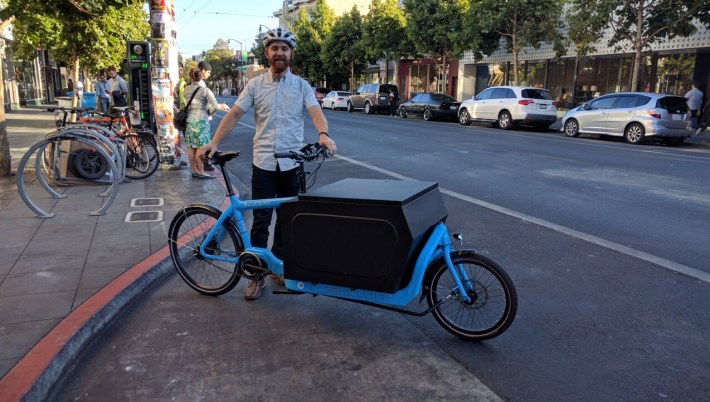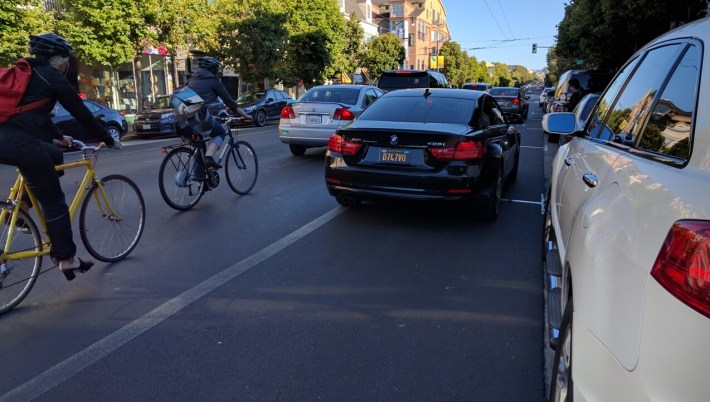
During yesterday evening's rush hour, safe streets advocates, organized by Catherine Orland, District 9 representative to the Bicycle Advisory Committee and longtime member and volunteer with the San Francisco Bicycle Coalition, started collecting hard data about how often the bike lanes on Valencia Street are blocked by motorists. Take a wild guess what they found: the bike lanes are a de facto loading-and-drop-off zone for cars.
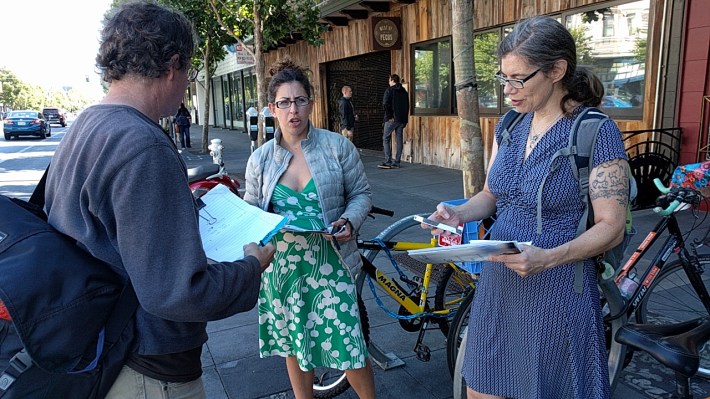
Who are these folks exactly and what do they want? From their flyer:
We're a small, committed group of folks who are concerned about public safety. Unfortunately, when cars are parked in bike lanes, this causes cyclists to enter into vehicle travel lanes. Cyclists are often forced to pedal in close proximity to cars that are traveling at much faster speeds. This endangers everyone!
Justin Balenzuela, from the Excelsior, studies urban planning at San Francisco State. He decided to volunteer for the count as a way to respond to the deaths of Kate Slattery and Heather Miller, two cyclists killed by speeding drivers late last month in separate incidents on the same evening. He says he is also looking out for his own neck, since he sees bike lanes blocked continually. "I ride every evening."
Ziggy Tomcich, another volunteer, who works for the SF Opera, said "I just wanted to do whatever I can--every day I have to zigzag in and out of bike lanes, so [if cars are parking in them] what's the point in having them?"
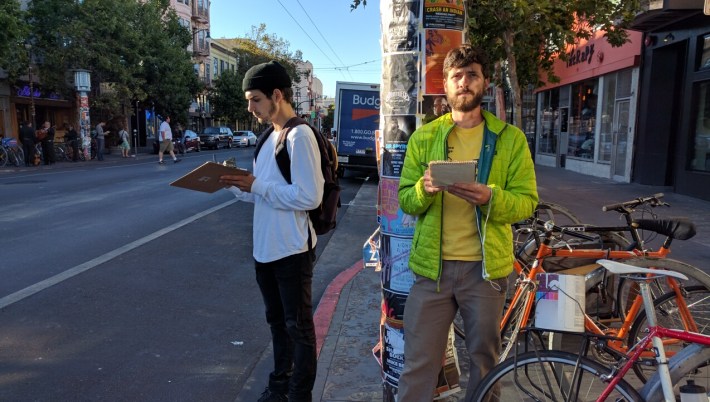
Balenzuela, Tomcich, and Adam Long, seen above in yellow, were eager to start counting. Orland assigned the volunteers to the stretch of Valencia from 16th to 17th and from 17th to 18th. One group took the east side of the street, others took the west. They milled around the curbsides, clipboards in hand, and logged each time a car blocked the bike lane in two categories: less than ten minutes or more than ten minutes. They also counted the number of cyclists who had to divert from the bike lane, in addition to recording the overall cycling counts from SFMTA's bike counter on Valencia. The data was split into three time periods: 4-5 p.m., 5-6 p.m., and 6-7 p.m.
In the first hour, violations were minimal. For example, on the west side of Valencia, between 16th and 17th St., there were only seven cyclists forced to divert by eight cars parked on the bike lane, all for less than ten minutes.
But things picked up--and got more dangerous--as the evening progressed. During the last hour, from 6-7 p.m. (Orland calls this the "death trap" hour) 205 bikes had to swerve into traffic on that same stretch of Valencia, thanks to 53 cars that blocked the bike lane--remember, that's just one block of Valencia, and just one side of the street.
Although not officially counted, the volunteers reported most of the cars had Uber or Lyft symbols on them. It should be noted that Streetsblog observed several police cars passing by, and two cops passing by on foot, but (no surprise) no citations were issued. That said, some drivers of the illegally parked cars seemed wary of the attention--one BMW driver drove off, but not before gesturing unkindly at Maureen Persico, a Bernal Heights resident and one of the counters.
Orland cautioned that her intention is not to shame motorists. "We don't want them to be more angry than they already are," she said. "This is about more than just any one interaction on the street...we want systemwide regulation and enforcement."
Pursuant to that, Orland shared some initial number crunching with Streetsblog in an email this morning:
The West side of Valencia between 16th and 17th saw some of the most flagrant disregard for safe operation of motor vehicles between 6 and 7pm. During the 6pm hour, on the West side of Valencia between 16th and 17th, motorists double parked at least once every two minutes. Furthermore, according to the data we collected, over 61 percent of traffic in the 6 to 7pm hour is comprised of cyclists. 205 cyclists were forced to merge into the vehicle travel lane during this hour, compromising their safety and forcing them to squeeze into a narrow travel lane alongside faster moving vehicular traffic. On multiple occasions, we observed cyclists taking evasive action and being forced to quickly maneuver out of the bike lane to avoid collisions with motorists who pulled over or pulled out abruptly, without signaling. This compelling data paints a clear picture of the threat to public safety posed by cars double parking in bicycle lanes. I hope that city officials and SFPD will carefully study this data and take action to ramp up enforcement--and prevent inevitable tragedy on this high injury corridor--before it is too late.
The group will continue to collect information.
That said, one of the individual bike lane interactions seemed worth noting. Emin Tekin, the owner of "Valencia and Kebab," watched as his employees rushed to unload a car illegally parked in the bike lane; the car had supplies for his shop. Tekin, who once lived in Rotterdam in the Netherlands, said Dutch bike lanes, which are typically to the right of the parked cars on busy streets, don't generate conflicts between motorists, cyclists and local businesses. He added that it's good for the health of the city because protected bike lanes encourage more cycling and walking. "Everybody is fit in Rotterdam. We can do better here," he added, pointing at the street.
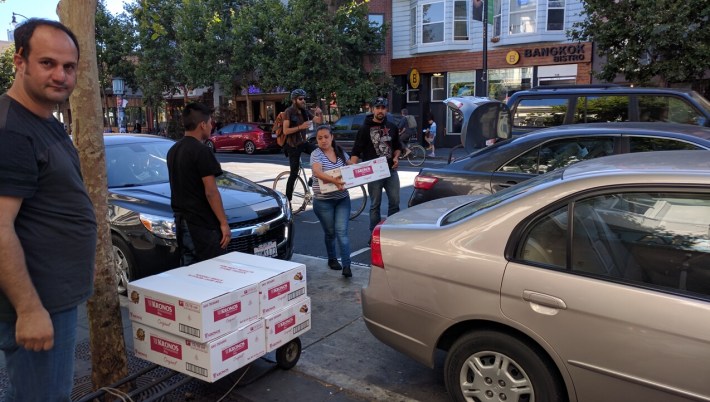
It should be noted that none of this work detracts from the efforts of the late-great bike advocate, Mary Brown, former Membership Director at the SF Bicycle Coalition. In 1999, she successfully campaigned for the striped lane on Valencia Street, one of the first bike lanes in the city. Local businesses and others fought that simple change. But bike counts increased 144 percent the following year from that breakthrough accomplishment.
But, as Orland's data is showing, times have changed. "I have been here long enough to remember Valencia street when it was a dream to bike on," said Persico. She recalled a time when the bike lane was mostly clear. "Now it's one of the most hazardous corridors because the Uber and Lyft drivers pull in and out of it," she said.
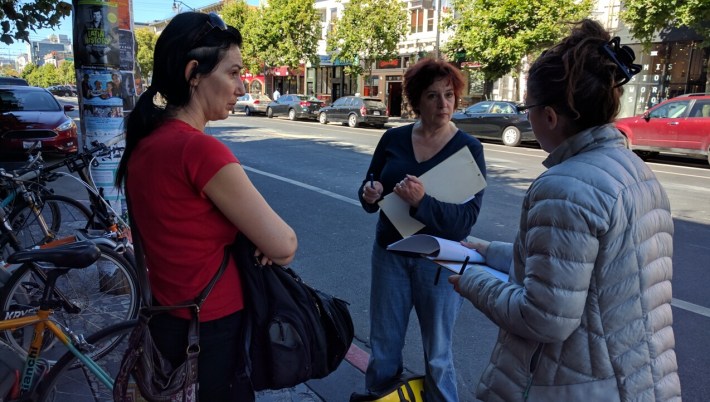
Enforcement of the current lanes and the eventual installation of protected lanes (and, it is hoped, protected intersections), however, require policy changes. And the first step towards that is hard information and lots of it, which is why Orland is doing the counts. "We're getting good data. We're counting lots of cyclists who were forced to go around stopped cars."
Interested in helping out? The group is doing another count tomorrow, Thursday, from 4-7 pm, at 16th and Valencia.
